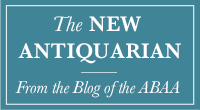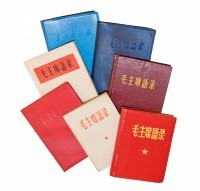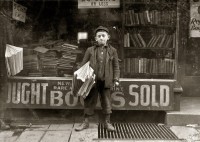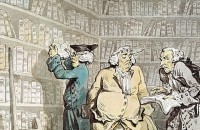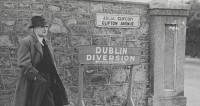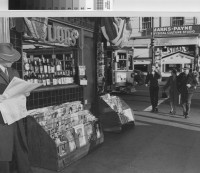The 1960s was a decade of both discovery and protest, riots and revolutions, from anti-war marches, assassinations of world leaders, man's first landing on the moon, and the birth of a new brand of music led by The Beatles. Change was in the air and nowhere was it more obvious than in modern China with the outbreak of the Cultural Revolution in August 1966. But more than two years earlier, before Chairman Mao ordered his Red Guards to restructure Society and re-educate intellectuals, there was the "Little Red Book" – a series of useful quotations gathered from Mao's earlier lectures and writings that would help guide his countrymen and women to deal with problems covering all aspects of daily life. The size of the book was small enough to fit inside a shirt pocket so it could be flush against the heart. Its phenomenal popularity may be because the book was essentially an unofficial requirement for every Chinese citizen to own, to read, to memorize and to carry copies at all times during the last ten years of Mao's rule, which essentially comprised the Cultural Revolution. Studying the book was not only required in schools but it also became a standard practice in the workplace. All units, in the industrial, commercial, agricultural, civil service, and military sectors, organized group sessions for the entire workforce to study the book during business hours that often extended into evening discussion meetings. During the middle to late 1960s, the book became the single most... [more 1964: The Little Red Book]
Enter the Blogosphere I promised another Facebook related post this week, but instead I think it's time to switch gears and get acquainted with some other social media options out there before you start to think that I'm on Mark Zuckerberg's payroll. This week I will consider the pros and cons of blogging as well as some of the better sites out there that support the endeavor. The fact that anyone with an internet connection and an email address can start a blog means that there is a huge range out there in terms of content as well as quality. And indeed, it sometimes feels like everyone and their cat has a blog these days. But as you will see, although it's a fairly easy thing to set up, it takes more than good intentions to sustain a blog over time. Nevertheless, the idea of having your own virtual soap box makes blogging an attractive option – and then of course there's always the hope that your blog will go viral and land you a six figure publishing contract and movie deal. Unfortunately, more often than not it will go something like this: Mr. Whiskers gets a great idea for a blog, writes two posts, and then gets “too busy” to update it for a year or three. Needless to say, don't follow Mr. Whiskers's example (I hear he's kind of aloof anyway). Blogging, like the rest of social media, takes a commitment from you in order to be a useful tool for your business. It can be a tougher pursuit in terms of time management because most blog entries tend to be quite a bit lon... [more THE SAVVY BOOKSELLER: Social Media for the Antiquarian Book Trade, Post #5]
This item is still missing as of 5/29/2019. The following item was reported missing from an apartment in Brooklyn: Duchamp, Marcel; Cage, John; Kubota, Shigeko (photographer). Marcel Duchamp and John Cage / Reunion. : Takeyoshi Miyazawa, . Oblong octavo, original blue cloth lettered in silver, clear dust jacket, blue endpapers. lllustrated with black-and-white photographs by Shigeko Kubota on rectos, acrostics by John Cage on versos. Hand-numbered 3 of 500 copies, inscribed by Shigeko Kubota on verso of front free endpaper: "David / with love Shigeko / 18 June '71." 33 rpm recording of the 1968 Duchamp/Cage Reunion chess match laid in. Tiny chips to spine ends of clear jacket. Housed in faded and scuffed blue card slipcase. First edition of this tribute to the celebrated 1968 chess match between Marcel Duchamp and John Cage, hand-numbered 3 of 500, inscribed by photographer Shigeko Kubota. If you have an information regarding this item, please contact Heather at: Honey & Wax Booksellers 540 President Street, Third Floor Brooklyn NY 11215 917-974-2420 heather@honeyandwaxbooks.com honeyandwaxbooks.com [more Missing: Duchamp, Marcel; Cage, John; Kubota, Shigeko (photographer)]
Back in the 1990s event promoter Bernice Bornstein saw an opportunity and took advantage of it. Her husband Marvin owned a parking lot directly across the street from the Hynes Auditorium, where the Boston International Antiquarian Book Fair was being held. “Why not have a smaller show for non-ABAA dealers that same weekend?” she asked. “We could use the basement of Marvin's garage.” Thus the first “Shadow Show” was born. The idea met intense resistance at first. Old-line ABAA dealers were concerned that another show would steal customers and dilute earnings. They feared the public would confuse the ABAA show, where rigid standards for dealers were enforced, with the non-ABAA show, where the only requirement was the ability to pay booth rent. They feared competition from dealers with lower overheads. They feared their stable price structures would be challenged by dealers out to make a quick buck. They feared a lot of things that never came to pass. Bernice's Shadow Show was a great success, and the old guard quickly realized that the existence of a second show benefited everyone. It wasn't long before promoters Garry Austin and Bruce Gventer transferred the Shadow Show model to the New York International Antiquarian Book Fair. This is the pre-eminent book fair in the country; one of the greatest in the world. By this time there was no doubt in anyone's mind that a second show would provide a tremendous opportunity for ABAA dealers to buy and for non-ABAA dealers ... [more Book Show Wars]
The following item was reported stolen from Monsey, NY on 10/10/14: (Bible in Hebrew) Vocalized text. Integral blanks present. This is 17 parts in 8 volumes. Samll format; 113 x 68mm. 16th century calf with gilt arabesque centerpiece on covers, vellum pastedowns from medieval Latin manuscript (of an abridgment?) of the Sentences of Peter Lombard. From the collection of the Scottish politician bibliophile Andrew Fletcher of Saltoun (1653-1716) with his signature on the title pages. If you have any information regarding this item, please contact Gene Albert at 301-988-6700 (daytime) or 301-331-5060 (evenings). [more Stolen: 8 Volume Hebrew Bible - Second Estienne Hebrew Bible]
The Lawbook Exchange just issued an E-List: Blackstone: 30 Items, inspired by the recent publication of Ann J. Laeuchli's Bibliographical Catalog of William Blackstone. Lowry-James Rare Prints & Books announced the publication of Catalogue Number Ten: Charles Livingston Bull. Joslin Hall Rare Books released Catalog #351: A Selection of Jane Yolen's Signed Poetry Broadsides and Catalog 352 - A Selection of Books & Ephemera for October. Margolis & Moss offers a list of 48 Portfolios of Prints, Photographs, Private Press Books, and Multiples. Rulon-Miller Books has a short list of recent acquisitions. Quill & Brush is offering a comprehensive collection of Eudora Welty material. Jeff Maser's latest arrivals include a collection of works by Simon Cutts among other interesting material. Kaaterskill Books published Catalogue 19: Latin Americana, which features works dating from the early 18th century to the end of the last century. Walkabout Books' latest Catalogue 3: An American Miscellany is available in digital and print formats. J & J Lubrano Music Antiquarians published their latest catalogue, The Collection of Jacob Lateiner Part 1: Beethoven First and Early Editions, and announced the availability of The Robert H. and Jaqueline M. Cowden Collection of Books Relating to Concert and Opera Singers. Thorn Books issued their Fall List of over 60 new items. Bolerium Books has a new catalogue out on Indigenous Activism and History in North America. James S. Jaffe Rare Books' new ca... [more October Catalogue and List Announcements]
ILAB is coordinating a series of Pop-Up Book Fairs across the world for UNESCO World Book and Copyright Day on April 23, 2015. The two organizations have created an offiial partnership for the event and ILAB is asking as many members as possible to organize and attend as many pop-up fairs as possible. Former President of the ABA Laurence Worms describes the envisioned pop-ups: “Some booksellers, some books, some tables and a big sign. Just liaise with ILAB on the publicity. No-one has to travel far or be away from base for too long. They can last all day or just an hour or two. Imagination and invention are the only limitations.” For more information, contact ILAB Committee Member Sally Burdon. Bridwell Library is pleased to announce the opening of two exhibitions on site and online this fall. "Welcome Additions" highlights fifty rare books, manuscripts, broadsides, prints, and letters that were acquired by Bridwell Library Special Collections between 2008 and 2014. It is open through December 12th. "Missionary Presses" highlights Bibles and other religious texts in indigenous languages published by missionary presses in the nineteenth century. It is open through December 5th. The digital exhibitions will continue to remain accessible after the exhibitions in the library have closed. Bernard Quaritch Ltd recently published a new book by Arthur Freeman entitled Bibliotheca Fictiva. It is an inventory of books and manuscripts relating to literary forgery. Click here for mor... [more Endnotes: Rare Books News & Events]
Rock Toews (Back Creek Books LLC) is a key player in determining whether a Maryland area slated for development was the site of a Civil War parole camp. Priscilla Juvelis contributed a chapter to an upcoming book on William T. Vollmann entitled William T. Volmann: A Critical Companion. Don Lindgren of Rabelais Inc. is interviewed for Eater's piece on 72 Ways Food Can Change the World. He is in good company with Alice Waters, Jose Andres, and Danny Meyer, to name a few of the other interviewees. An interview with Leonard Fox on fashion illustration appeared in the September issue of Traditional Home magazine. Kevin Mac Donnell contributed the third chapter to the recently published Collecting, Curating and Researching Writer's Libraries, A Handbook edited by Richard Oram and Joseph Nicholson (Rowman & Littlefield, 2014). An excerpt was posted on The New Antiquarian and you can read the article in its entirety in our Member Articles section. If you are interested in purchasing the book, please note the promotional code. [more New Antiquarians in the News]
To mark the 75th Anniversary of 1939, we've asked some ABAA members to discuss publications from that momentous year. Garrett Scott, a prominent Ann Arbor bookseller, offers a divagation upon At Swim-Two-Birds, Flann O'Brien's proto-post-modern first book– published in 1939. Biographical reminiscence, part the first: Sometime in 1991, I had taken up temporary residence in a storage closet in a university-owned cooperative house. This was during a period in college in which I was neither enrolled in any classes nor strictly speaking in the eyes of the university a resident of the university-owned cooperative house. The storage closet was situated within one easy extension-cord's length of a hallway electrical outlet and thus easily outfitted with a small fan and a reading lamp and a clock radio. A spare mattress fit neatly between the stacks of cardboard boxes and assorted lumber. The storage closet had the added utility of providing my then-girlfriend with a place to lodge me when she sought respite from my company. One evening prior to another bout of rustication she endeavored to occupy me by handing me a paperback copy of a book written by a man named Flann O'Brien, a member of the Irish nation. The name of the book was At Swim-Two-Birds. She told me the book was about a college student trying to write a book. Nature of her summary: Perfunctory. The figure of speech she had inadvertently employed: Understatement. And thus with nothing but the hum of the fan beside my mat... [more 1939: At Swim-Two-Birds]
We asked Michael Hackenberg, Chair of the Northern California Book Fair Committee, to provide his personal perspective on the decision to move the ABAA-sponsored California International Antiquarian Book Fair from San Francisco to Oakland. (Our California fairs alternate between Southern California and Northern California.) Knowing the Concourse was no more, the Book Fair Committee basically had two options (since the Yerba Buena Center and its big San Francisco downtown Marriott laughed at our small size): Fort Mason or the Oakland Marriott City Center. Site visits and many discussions led the Committee to select the Oakland location. It boasts a brightly lit and large exhibit hall with no dividing wall (and no leaking roof), easy self-loading and unloading, plus smooth arrangements for both EPI (our local union crew located on nearby Alameda and already very familiar with the venue) and Caladex (I personally walked through the venue with both of those firms' representatives, and they were quite pleased with the logistical situation). It has a quality hotel on-site with very advantageous room rates (the Committee looked over the rooms carefully). Its great East Bay location has three freeways joining at the Bay Bridge approach and an ample parking garage. There is a 12th Street BART stop right at the door, with direct connections from Millbrae on the SF Peninsula, Fremont, Richmond/Berkeley, and all the wealthy Bay Area suburbs on the back side of the East Bay hills (Walnut ... [more Across the Bay: ABAA California Fair Moves to Oakland]

